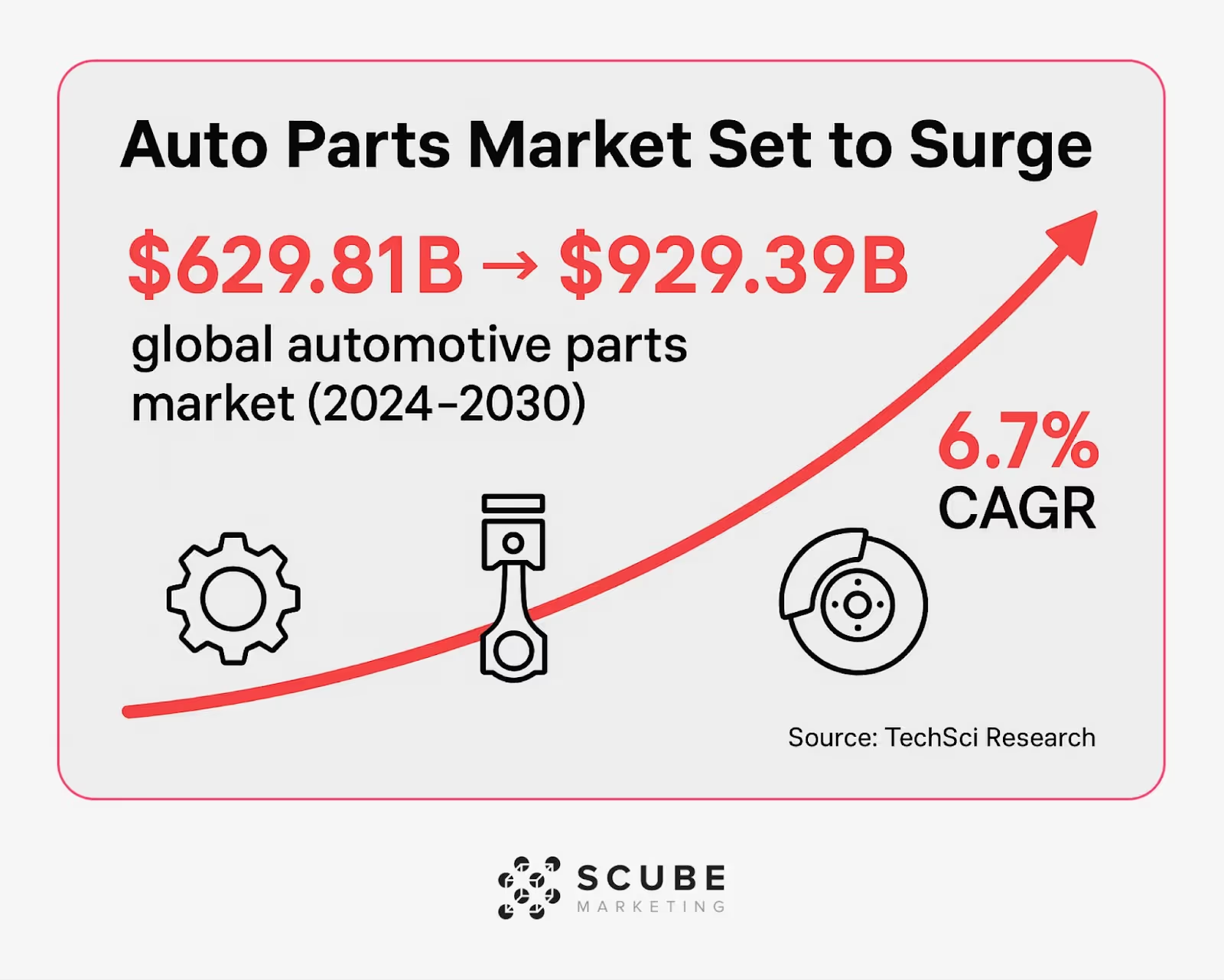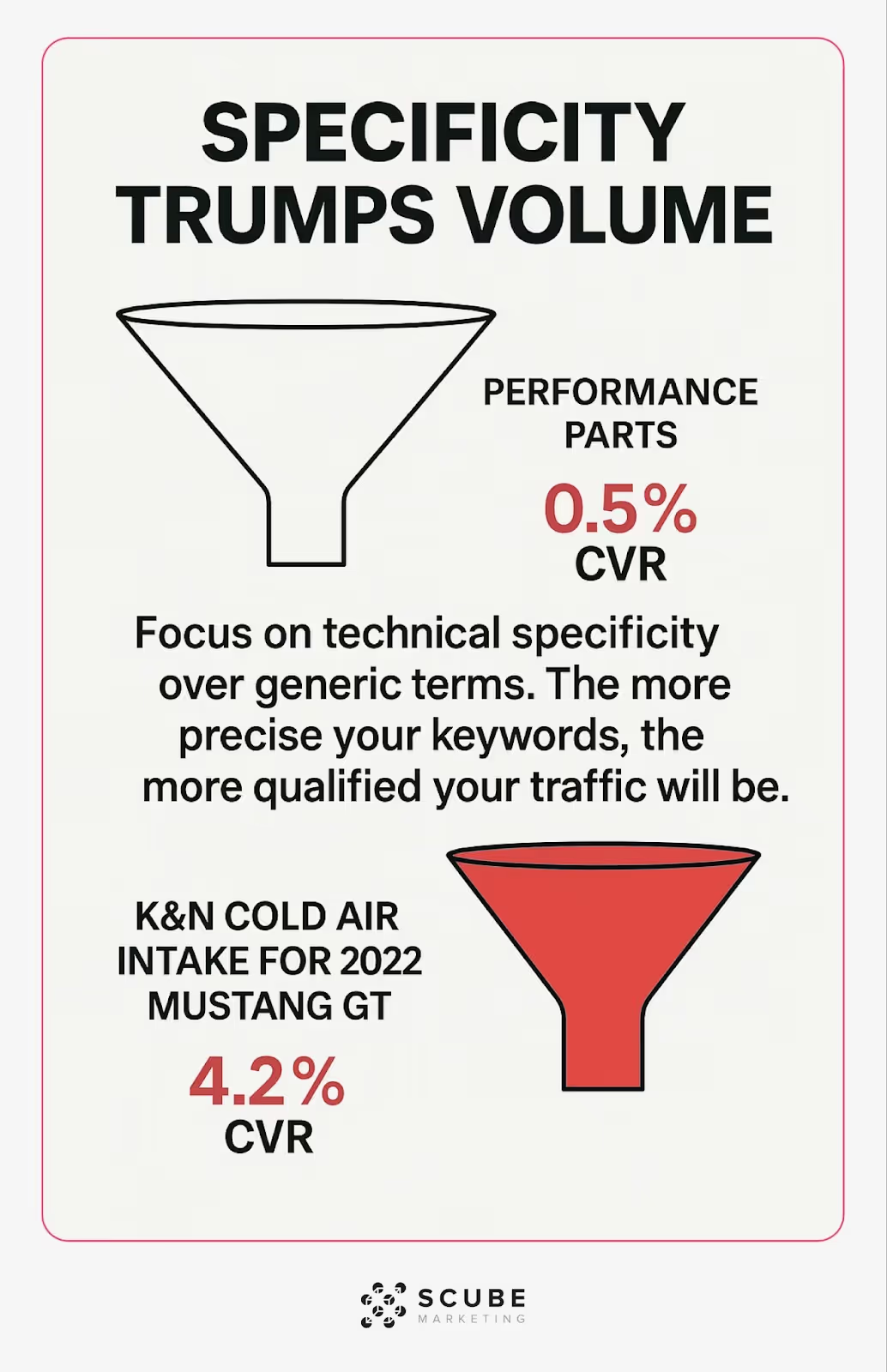
The high-performance auto parts industry presents massive opportunities for online sellers. With proper keyword research, you can capture this growing market effectively. Targeting the right search terms connects your products with enthusiastic buyers actively looking for performance upgrades.
I've worked with numerous automotive aftermarket businesses through my agency Scube Marketing. The difference between struggling stores and successful ones often comes down to keyword strategy. The right approach can dramatically increase visibility and sales.
In this guide, I'll share proven keyword research techniques specifically for high-performance auto parts. These strategies work for both established businesses and newcomers to the performance parts space. Let's examine what makes automotive keyword research unique and how to leverage it for your business.

Before looking into keyword strategies, let's look at the current auto parts market size and trajectory. The global automotive parts market is valued at $629.81 billion in 2024 and projected to reach $929.39 billion by 2030, growing at a 6.7% CAGR. (Source: TechSciResearch)
The aftermarket sector specifically shows strong momentum with a forecast 5.5% CAGR in the coming years. (Source: IndustryARC) This growth creates both opportunity and competition for online retailers.
.avif)
Within this broader landscape, the auto parts and accessories market is expected to grow from $84.93 billion in 2024 to $117.05 billion by 2034 at a 3.24% CAGR. (Source: Zion Market Research) This segment includes the high-performance niche we're focusing on.
Several factors drive this growth. Key among them are the rising demand for electric vehicle components and advanced driver-assistance systems (ADAS). (Source: Zion Market Research) These trends directly impact keyword strategy for performance parts retailers.
Let's look at how the auto parts market breaks down by region and category:

The Asia-Pacific region dominates the automotive parts market currently. (Source: TechSciResearch) This geographic insight helps inform international keyword strategies for businesses looking to expand globally.
The auto parts market's competitive nature makes strategic keyword research essential. With thousands of retailers competing for visibility, generic approaches fall short. Performance auto parts buyers use highly specific search terms.
I've noticed automotive shoppers typically know exactly what they want. They search for specific part numbers, performance specifications, and vehicle compatibility. This behavior creates both challenges and opportunities for keyword strategy.
Poor keyword research has several consequences for auto parts retailers:
The technical nature of performance auto parts makes keyword research even more crucial. Buyers often use specialized terminology, brand names, and performance metrics in their searches. Understanding these patterns directly impacts your visibility.
Effective keyword research for auto parts requires a specialized approach. The technical nature of the industry demands attention to detail. Let's explore proven strategies that drive results.
Begin by analyzing competitors who rank well for your target products. This reveals valuable keyword patterns and opportunities. I recommend creating a spreadsheet to track competitor keywords systematically.
The most successful auto parts retailers build keyword strategies around specificity. Generic terms like "car parts" or "performance parts" bring traffic but convert poorly. Focus instead on detailed, product-specific keywords with clear purchase intent.
Here's a simple process I use with automotive clients:

Performance auto parts buyers are typically knowledgeable enthusiasts. They search using specific technical terms, specifications, and part numbers. Your keyword strategy should reflect this behavior.
When researching keywords for high-performance parts, include:
This level of specificity connects your products with buyers who know exactly what they want. These searches typically have higher conversion rates despite lower search volume.
Vehicle compatibility drives many auto parts searches. Your keyword research must account for the various ways shoppers specify vehicle information. This creates numerous keyword combinations to target.
Let's examine how vehicle compatibility affects keyword structure:
Create a systematic approach to combining these elements in your keyword research. The possibilities are extensive, so prioritize based on your inventory and target audience.
Brand affinity strongly influences performance parts purchases. Many enthusiasts search specifically for preferred brands combined with part types. This creates valuable long-tail keyword opportunities.
For example, rather than just targeting "cold air intake," expand to brand-specific variations:
This approach connects with brand-loyal customers who have already narrowed their consideration set. These searches typically indicate higher purchase intent and product knowledge.
Performance auto parts buyers often include their goals in search queries. They want products that deliver specific improvements. Your keyword research should capture these intent-driven searches.
Examples of performance-focused keyword modifiers include:
These modifiers create valuable long-tail keywords that match specific buyer intentions. They typically convert better than generic product searches.
The right tools significantly improve your keyword research efficiency and effectiveness. I recommend using a combination of general SEO tools and automotive-specific resources.
Here's a comparison of valuable keyword research tools for auto parts businesses:
Beyond these general tools, automotive-specific resources provide valuable insights. Forums, manufacturer websites, and marketplace platforms all offer keyword opportunities.
Marketplace platforms offer valuable keyword insights for auto parts. Amazon and eBay's search suggestion features reveal how shoppers phrase their queries. These platforms process millions of automotive searches daily.
I find Amazon particularly valuable for auto parts keyword research. Their suggestion algorithm reflects actual customer behavior. Pay special attention to:
Product titles from top sellers often reveal effective keyword patterns. Note how they structure information and which technical details they emphasize. These patterns show what converts in the largest automotive marketplace.
The search suggestion dropdown also highlights common modifiers that shoppers use. These suggestions come directly from actual search behavior, not theoretical keyword research.
Discovering the right keywords is just the first step. Strategic implementation across your website determines their effectiveness. Let's examine how to properly use keywords throughout your auto parts store.
Product titles significantly impact search visibility for auto parts. They need to balance keyword inclusion with clarity and specificity. An effective title structure includes:
For example, instead of "Performance Cold Air Intake," use "K&N Cold Air Intake System for 2018-2022 Ford Mustang GT 5.0L - Increases Horsepower by 15HP - 57-3082."
This structure frontloads critical keywords while providing complete information. It matches how performance enthusiasts actually search for parts.
Product descriptions offer opportunities to include additional keywords naturally. Focus on solving customer problems and addressing key purchase considerations.
Effective auto parts descriptions should include:
Detailed compatibility information that expands beyond the title. List all compatible vehicles, including variations in trim levels and engine options. This captures long-tail searches for specific vehicle configurations.
Performance benefits with specific metrics help both users and search engines understand the product value. Include actual numbers when possible, such as "gains up to 15 horsepower" or "reduces weight by 5 pounds versus stock."
When integrating keywords, prioritize natural language over keyword stuffing. Search engines penalize unnatural keyword usage, and it creates a poor user experience.
Category pages often rank well for broader auto parts search terms. They require different keyword strategies than product pages. Optimize these pages for part type and vehicle searches.
Here's a structured approach to category page optimization:
Well-optimized category pages serve both search engines and users. They provide context about the products while targeting valuable broader keywords.
Part numbers and manufacturer data play crucial roles in auto parts SEO. Many shoppers search directly for these specific identifiers. Properly implementing this information improves visibility for high-intent searches.
Integrating MPNs (Manufacturer Part Numbers) correctly helps your high-performance auto parts appear in relevant searches. Include these identifiers in:
Product titles (when space permits) place part numbers toward the end after more descriptive information. This balances human readability with search optimization.
Early in product descriptions, restate the part number in context. This reinforces its importance for both users and search engines scanning your content.
This approach targets buyers who already know exactly what part they need. These searches typically indicate high purchase intent and quick conversion.
Implementing keywords is just the beginning. Continuous measurement and refinement drive long-term success. I focus on specific metrics when evaluating auto parts keyword performance.
The most important performance indicators include:
Organic traffic by keyword shows which terms actually bring visitors to your site. This data reveals which keyword investments are paying off in visibility.
Conversion rate by keyword indicates which terms attract ready-to-buy customers. Technical, specific keywords typically convert better than generic ones in the auto parts industry.
These metrics reveal which keywords deliver actual business results, not just traffic. Performance auto parts retailers should prioritize conversion quality over raw visitor numbers.
The automotive performance parts market experiences significant seasonal variations. Keyword popularity shifts throughout the year based on:
Racing seasons drive interest in specific performance categories. Track day enthusiasts often search for upgrades before the season begins, creating predictable search patterns.
Car show schedules influence aesthetic modification searches. Interest in visual upgrades peaks in the weeks leading up to major events and meets.
The following table shows how different high-performance part categories experience seasonal search trends:
Aligning your keyword focus with these seasonal patterns improves campaign efficiency. It ensures you target the right terms when purchase intent is highest.
Google Search Console provides valuable insights about which keywords actually bring visitors to your auto parts store. I regularly mine this data for new opportunities.
The process I recommend includes:
Identify which pages receive impressions but low clicks. These represent visibility opportunities where minor optimization could significantly improve results.
Analyze the specific queries triggering these impressions. Look for patterns in how customers search for your products. This often reveals keyword variations you hadn't considered.
This approach leverages actual search data rather than theoretical keyword research. It reveals how real customers find and interact with your store.
Keyword research shouldn't exist in isolation. Effective auto parts marketing integrates these insights across multiple channels. This creates consistency and reinforces your visibility.
Consider how your keyword strategy influences:
Paid search campaigns should align closely with organic keyword targets. Use your research to inform ad copy, extensions, and campaign structure for maximum efficiency.
Social media content performs better when it incorporates the same language your customers use in searches. Your posts should mirror the terminology that drives your website traffic.
A cohesive approach strengthens brand recognition and improves performance across channels. The language you use should remain consistent while adapting to each platform's requirements.
For auto parts retailers, keyword strategy and inventory management are closely linked. Popular search terms should influence purchasing decisions and stock priorities.
I recommend regular analysis of:
Which keywords drive the most revenue helps prioritize inventory investments. Stock more of what customers actively search for and purchase.
Search trends for specific parts or categories reveal emerging opportunities. Monitoring these patterns helps you stay ahead of market shifts and competitor offerings.
This data helps predict demand and align inventory with customer search behavior. It reduces the risk of stocking parts with limited search interest.

Effective keyword research gives high-performance auto parts retailers a significant competitive advantage. The strategies outlined here connect your products with enthusiastic buyers who know what they want.
Remember these key principles:
Focus on technical specificity over generic terms. The more precise your keywords, the more qualified your traffic will be.
Build comprehensive vehicle compatibility keyword sets to capture the full range of potential customers. Think year, make, model, and trim level variations.
Include brand, part type, and performance benefit combinations to target buyers at different stages of the purchase journey.
The auto parts market continues growing rapidly. With targeted keyword research, your business can capture a meaningful share of this expansion. The effort invested in research pays dividends through improved visibility and sales.
Ready to take your auto parts keyword strategy to the next level? Start by auditing your current approach against these best practices. Identify gaps and opportunities specific to your product range. Then implement improvements systematically, measuring results as you go.